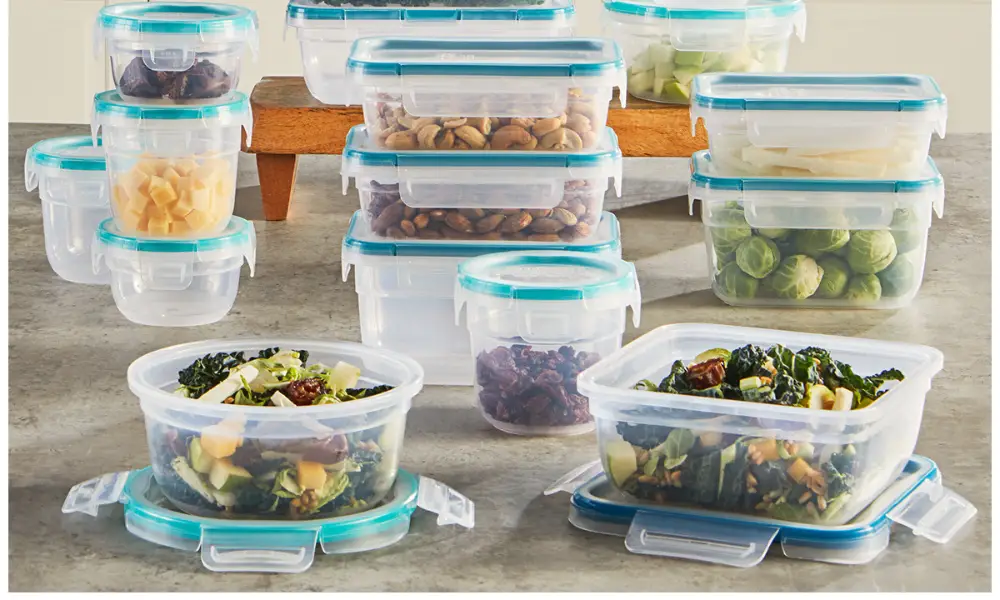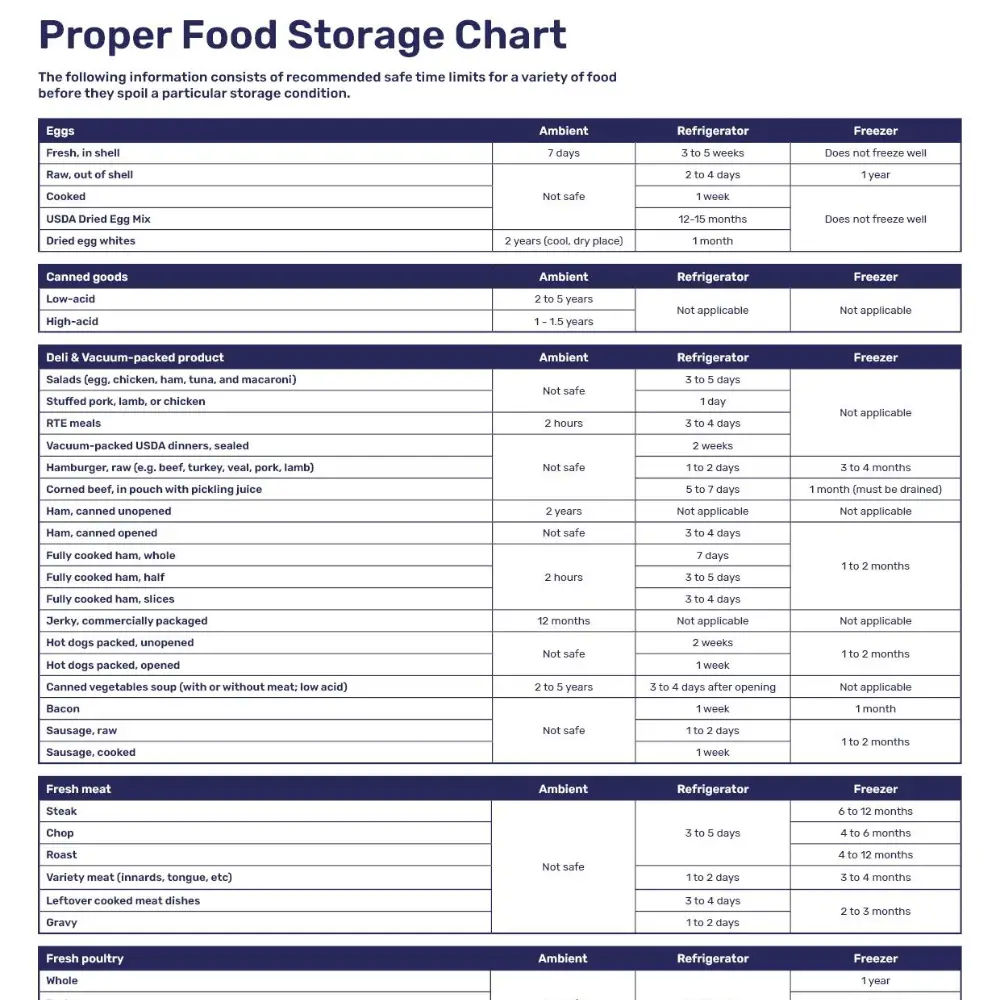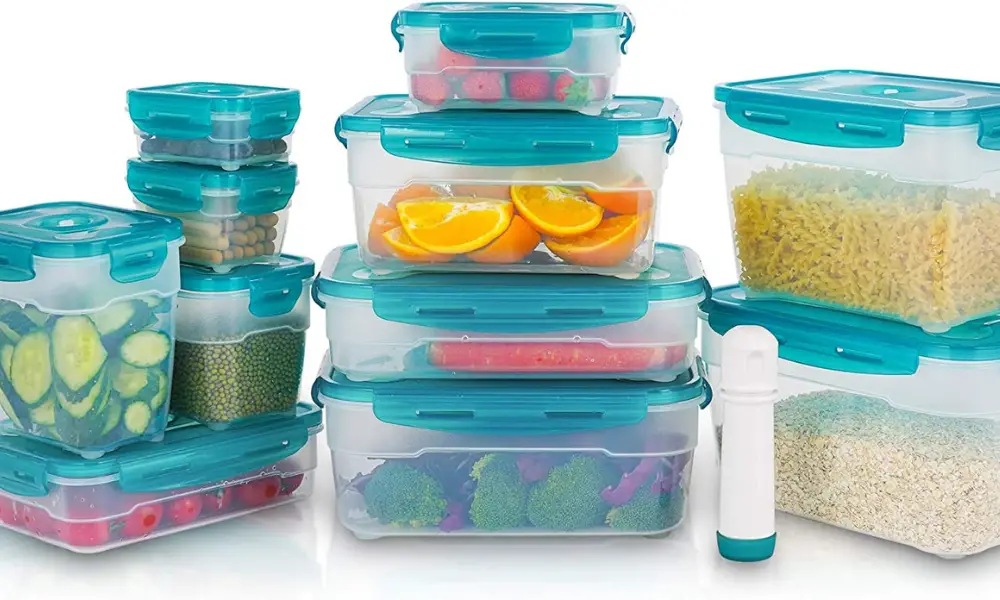The Food and Drug Administration (FDA) claims that by preserving flavor, color, texture, and nutrients in Food, effective home food storage helps maintain food quality and safety. The shelf life of many common foods and canned goods is quite long. Foods stored longer than advised or after the package’s expiration date, however, may lose some of their quality, color, and flavor.
Whether you are looking for the best way to store your Food or need a little help planning your food storage, a food storage chart is a great way to get you started. It will help you determine how long your Food will last and what foods you should keep in the refrigerator or freezer.

What is the Meaning of Food Storage?
Food security is crucial for the majority of people worldwide who depend on others to produce their food, as well as for the preservation, storage, and transportation of food, including timely delivery to customers.
Food storage is a useful tool to combat the natural, inescapable fluctuation of the food supply. It enables Food to be used after harvest (usually weeks to months) rather than immediately. It is a well-established residential skill (mostly root cellaring) and a significant industrial and commercial activity in food logistics.
Reduced shelf life of products is caused by decisions made earlier in the supply chain and poor storage conditions, resulting in significant food losses.
Using a Food Storage Chart to Plan your Food Storage
Maximum 2 Days
Ground beef, veal, pork, lamb, veal, turkey, stew meats, a variety of meats, whole chickens or turkeys, giblets, raw or poultry sausage, fresh fish, and shellfish are all examples of meats.
Maximum 4 days
Cooked casseroles, cooked soups and stews, cooked egg dishes, gravy, broth, patties, and nuggets, prepared meals from a grocery shop and fully cooked ham slices.
Maximum 5 days
Egg, chicken, tuna, ham, and macaroni salads; opened luncheon meats; completely cooked ham, half; and ham in a can that says “Keep Refrigerated.”
Maximum 7 days
Bacon, links or patties of smoked sausage, whole, fully cooked ham, and pouches of corned beef (with pickling juices)
Around 2 weeks
Luncheon meat and hot dog containers are still sealed.
Around 3 weeks
Summer sausage packages that have been opened; hard sausage (such as pepperoni)
This chart serves as a general reference. Something should be thrown away if it displays spoilage, such as an unappealing odor, discoloration, or an ill flavor.
The number of times leftovers should be stored on the ingredient that spoils the fastest. For instance, even though the bacon would be excellent for a further three days, a casserole containing bacon should only be stored for four days.

What are the Tips that Must be Kept in Mind While Storing Food?
When it comes to food storage, there is no one size fits all solution.
Never keep (or even consider storing) Food that you or your family dislikes or rarely eats. Refrain from doing it, despite the advice from 1,000 web sources. (Lima beans, you are in my sights.) Both time and money are being wasted.
To create a food supply or an interest-worthy food store (if such a thing exists), avoid going to extremes or taking on debt.
If you’re beginning from scratch, start with one day’s worth of supplies (yes, only one day!) and increase your stock over time. Build up to organizing and purchasing a one-week supply once you know how much you’ll need for one day, and so on.
Instead of storing Food in a hidden underground stockpile that can remain unopened for 30 years, consider food storage. It may sound strange, but it’s effective.
What is the Importance of Storing Food Safely?
Here are a few compelling arguments for why Food should be properly preserved as an eye-opener:
Keep Stomach Illnesses and Food Poisoning at Bay
If you’ve ever experienced food poisoning, it’s important to remember that it will be among the most terrible situations you’ve ever encountered.
You may achieve this by ensuring that the Food you consume is constantly clean, which is one of the simplest and most efficient ways to do so. This also indicates that you’ve properly preserved leftovers and prepared meals.
Contribute to Reducing Bacterial Growth
Certain types of Food can easily support the growth of bacteria. Refrigerating the Food is the only way to prevent this. You can preserve the safety of your Food in this manner.
Furthermore, you are prepared to lengthen its shelf life. This results in more practical and affordable means.
Extension of Shelf Life
Different food types have a varying shelf life.
Since many factors, including the quality of storage at the grocery store, the preparation of the Food, and the humidity and temperature of your food storage area, affect how long a specific food type will be able to maintain its quality, there is no precise way to determine how long a particular food type will be able to do so.
Food that is stored improperly is only subject to early deterioration.
What are the Different Methods of Food Storage?
The fundamental components of your food stockpile are dry staples. These include flour, sugar, rice, beans, coffee, pancake mix, and instant potato flakes. These dry commodities are the most durable component of your food storage because they can be kept for thirty years or longer. The most affordable and nutrient-dense rations are typically fairly hefty and can frequently be found in bulk at many grocery stores.
To create freeze-dried rations, Food must first be frozen before being placed in a vacuum chamber and dried to remove any remaining moisture.
Although they are likely the most expensive food storage option, they are healthful, flavorful, and incredibly light and portable, requiring only hot water to rehydrate. Additionally, they claim to last for more than 20 years. They are frequently marketed by specialized businesses and online in nitrogen-sealed cans.
Dehydrated Food is portable, long-lasting, and has many of the same qualities as freeze-dried Food. Although it tends to be more expensive and is frequently offered by specialized businesses that sell everything from powdered milk and eggs to dry brownie mix, it is less bulky and less prone to spoilage than freeze-dried rations.
How to Tell Food has Gone Bad?
Eyes Have it
Food deterioration is indicated by visible mold development and changes in the color and texture of the Food. You can’t cut away mold spots, advises the United States Department of Agriculture, except hard cheeses, some salami, dry-cured country hams, and tough fruits and vegetables like cabbage, bell peppers, and carrots (USDA). Although mold may appear isolated in one area, its filaments can eat far into the Food, where they are invisible. Mycotoxins are released by mold spores, which can make you sick if you consume them.
Smell
After visually checking your Food for mold, please give it a quick whiff to check for undesirable odors. Your Food is probably spoilt if it smells bad. It is advised against attempting to smell rotten foods since you risk inhaling mold spores and developing an allergic reaction. Over time, the Food is broken down by the microbes and enzymes that cause spoiling, creating an unpleasant smell. Foods with any form of fat react with oxygen to create very obnoxious carbon-based chemicals, which are signs of spoiling.
Taste
Food tastes bad because of the way microbes decompose it. Taste your Food but don’t swallow it if it looks and smells good. The flavor of spoiled Food is sour, bitter, or fermented. When you cut into spoiled Food, it may have a slimy, squishy, or mushy feel and a terrible flavor. To prevent consuming hazardous bacteria, spit out the Food that tastes bad and rinse your mouth with water.
What are the Side Effects of Consuming Spoiled Foods?
Bacteria, parasites, or viruses are the three main causes of most food poisoning cases.
Due to their lack of preparation, raw foods frequently cause food illness. The majority of the Food that people eat contains these viruses. However, viruses on Food are often killed by heat during cooking before it reaches our plate.
Occasionally, fecal debris or vomit-borne pathogens will contact Food. This is most likely to happen if a sick person prepares Food without washing their hands beforehand.
Products, including meat, eggs, and dairy, are regularly contaminated. Additionally, disease-causing microorganisms may be present in water.
Most frequent types of food poisoning take four to twenty-four hours to manifest, although sometimes it takes longer. Some foodborne infections are latent, which can develop in your body without causing symptoms. For instance, the Hepatitis A virus may go undetected for 15 to 50 days.
Reference: Publikation C: Predicting the consumption of expired Food by an Extended Theory of Planned behavior.
Consumption habits of consumers about expired Food and preventing food waste. “Items that depart from normal or optimal products on the basis of their date labelling (e. g., near to or beyond the best-before date)” are referred to as “expired food.” It stands for a significant behavioral category that prevents food waste.
Several findings from earlier studies suggest that home food waste is brought on by Food that has passed its best-before date. For instance, research reveals a general lack of consumer comprehension of various date labels and their impression of significant health hazards associated with date labeling. Because of this, consumers frequently prefer to dispose of food past its expiration date rather than consuming it or subjecting it to additional sensory evaluation.
Conclusion
The most important food-related lesson is to handle your leftovers with care. It would be best to wash your hands before handling them and leave a little space around the container. If you can’t fit your hands into a refrigerator-safe container, use a shallow dish and a damp towel to help keep your seafood from smearing.
A food safety temperature chart is a good way to keep Food safe and prevent foodborne illnesses. The temperature chart will guide you in the right direction and show you where to store your food. The chart also helps to identify the best cooking temperatures for various key foods.
